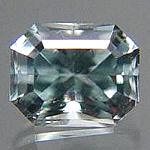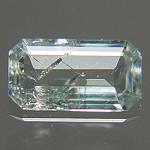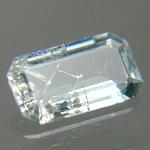|
|
||||||||||||||||
|
||||||||||||||||
|
||||||
|
|
|
|
Barite
(Baryte)
|
|
| | |
| Discovered in 1640; IMA status: Valid (pre-IMA; Grandfathered) | ||
|
| ||
|
Chemistry |
|
|
| |
|
Ba(SO4) | |
|
|
Barium Sulfate |
|
Molecular Weight: |
233.39 gm |
|
Composition: |
Barium |
58.84 % |
Ba |
65.70 % |
BaO |
|
|
Sulfur |
13.74 % |
S |
34.30 % |
SO3 |
|
|
Oxygen |
27.42 % |
O |
|
|
|
|
|
100.00 % |
|
100.00 % |
= TOTAL OXIDE |
|
|
|
||||
|
Classification |
|
|
| |
|
Sulfates | |
|
6/A.09-20 | |
|
|
7 : SULFATES (selenates, tellurates, chromates, molybdates,
wolframates) |
|
Related to: |
Barite Group. Baryte-Celestine Series. The barium analogue of Celestine. |
|
Members of Group: |
Barite Group: Anglesite, Barite, Celestine, Hashemite |
|
Varieties: |
Angleso-barite, Baryte Rose, Ca- and Sr-rich Baryte, Calcareobarite, Celestobarite (of Dana), Hokutolite, Meißelspat, Oakstone, Radian Barite, Schoharite, Strontian Barite, Strontian Baryte |
|
Synonyms: |
Astapia, Astrapia, Baritite, Baryte, Baroite, Baroselenite, Barote, Barytes, Barytine, Barytite, Bologna stone, Bolognian Spar, Bononian stone, Boulanite, Boulonite, Calk, Calstronbarite, Cauk, Cawk, Dreelite, Dréelite, Fetid Heavy Spar, Heavy Spar, Tiff, Volnye, Yellow Spar |
|
|
|
|
Crystal Data |
|
|
|
|
|
Commonly in well-formed crystals, to 85 cm, with over 70 forms noted. Thin to thick tabular; also prismatic, equant. As crested to rosettelike aggregates of tabular individuals, concretionary, fibrous, nodular, stalactitic, may be banded; granular, earthy, massive. |
|
|
None |
|
|
|
|
|
Physical Properties |
|
|
|
|
|
Perfect on {001}, less Perfect on {210}, Imperfect on {010} |
|
|
Irregular/Uneven |
|
|
Brittle |
|
|
3.0 - 3.5 |
|
|
4.48 - 4.50 (g/cm3) (very heavy for a non-metallic mineral) |
|
|
May fluoresce in shades of yellow or white (Franklin & Sterling Hill, NJ), occasionally orange or pink under LW UV and phosphoresce cream or strongly greenish-white to spectral colors under UV. May be thermoluminescent at times. |
|
|
Not Radioactive |
|
|
Other: |
Slightly
soluble in water, more so in solutions of salts
or acids. |
|
|
|
|
Optical Properties |
|
|
|
|
|
Colorless, White, Yellow, Brown, Gray, pale shades of Red, Green, Blue, may be zoned, or change color on exposure to light |
|
|
Transparent to Translucent to Opaque |
|
|
Vitreous, Pearly |
|
|
1.634 - 1.648 Biaxial ( + ) |
|
|
0.0110 - 0.0120 |
|
|
Weak; r > v |
|
|
Weak;
Color X Y Z
|
|
|
|
|
|
Occurances |
|
|
|
|
|
Geological Setting: |
Commonly found as a gangue mineral in metallic ore deposits of epithermal or mesothermal origin; but it may also be found as lenses or replacement deposits in sedimentary rocks, both of hypogene and supergene origin. |
|
Common Associations: |
Calcite, Dolomite, Fluorite, Galena, Magnatite, Pyrite, Quartz, Siderite |
|
Common Impurities: |
Sr, Ca, Pb |
|
Type Locality: |
n/a |
|
Year Discovered: |
1640 |
|
View mineral photos: | |
|
|
|
|
More Information |
|
|
|
|
|
| |
|
|
|
|
Barite is unusual in that it is a diamagnetic mineral. Diamagnetism is a form of magnetism where certain minerals are repelled by an externally applied magnetic field, and form internal induced magnetic fields in the direction opposite to that of the applied magnetic field. In contrast with this behavior, some minerals, such as Xenotime, are paramagnetic. Paramagnetism is a form of magnetism where certain minerals are attracted by an externally applied magnetic field, and form internal, induced magnetic fields in the direction of the applied magnetic field. Some
notable sources of
facetable crystals are Thunder Bay District, Ontario,
Canada (colorless); Rock Candy Mine, British Columbia,
Canada (yellow); Cumberland, England; and in the USA
from Meade County, South Dakota (brown); the Book Cliffs,
near Grand Junction, Colorado (colorless); and
Stoneham, Weld
County, Colorado (blue). There are many other locations
for Barite. |
|
|
||||||||||||||||||||||||||||||||||||||||||||||||||||||




